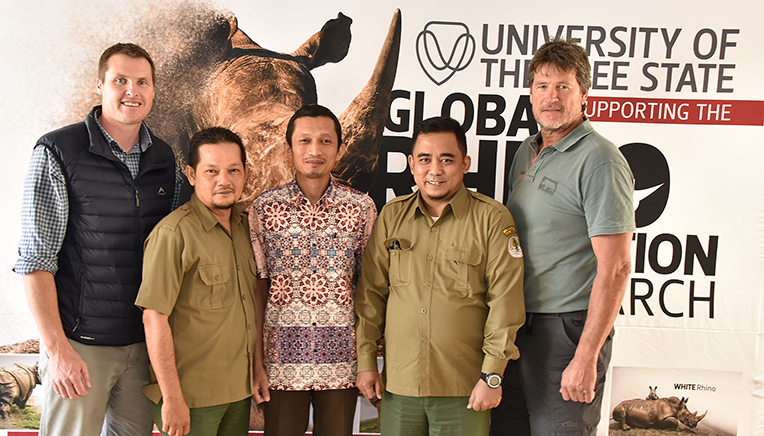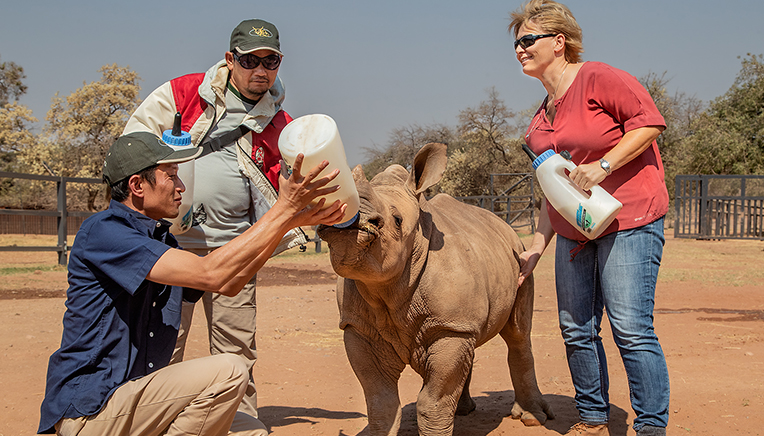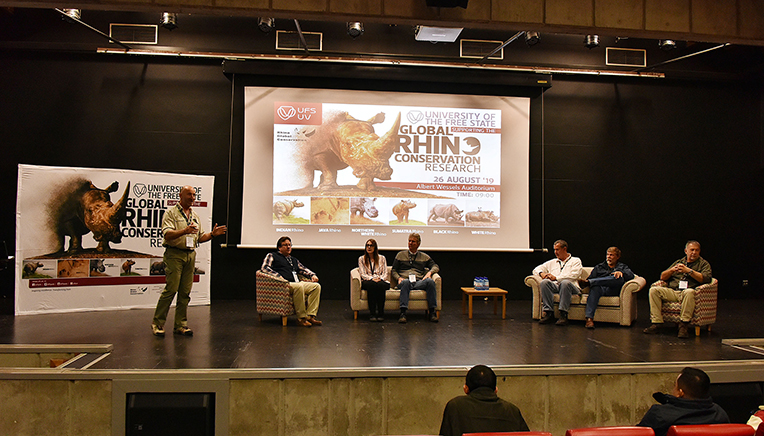Water, cold, thirst, volcanoes …. and poaching, are causing the death of rhinos across the globe.
Recently, a group of scientists and rhino activists met at the University of the Free State (UFS) to discuss the plight of rhinos in South Africa. Bringing an international perspective to the colloquium on global rhino conservation, were three delegates from Indonesia who are working with the most endangered rhinos on earth – the Javan and Sumatra rhinos.
Dr Rudi Putra, a biologist, received a Goldman Environmental Prize in 2014 for his efforts to save the Sumatra rhinos – of which an estimated 65 individuals are left in the
Gunung Leuser National Park. Muhamnad Syamsudin is responsible for a 30-person rhino protection unit, which has not lost one rhino to poaching in
Ujung Kulon National Park in 19 years. The third person from the Indonesian delegation was Dr Firmanto Noviar Suwanda, a lead scientist in rhino observation data, with a 30-person rhino monitoring unit, also in Ujung Kulon National Park.
Also presenting at the colloquium, were researchers from an inter-disciplinary team at the UFS, who are working together to establish a rhino conservation model through research and teaching.
The colloquium was convened by the UFS.

At the colloquium to discuss the conservation of rhinos, were from the left: Dr Francois Deacon, Muhamnad Syamsudin
(responsible for a 30-person rhino protection unit – not losing one rhino to poaching in 19 years in Ujung Kulon National Park),
Dr Rudi Putra (biologist who received a Goldman Environmental Prize in 2014 for his efforts to save the Sumatra rhinos), Dr Firmanto Noviar Suwanda
(lead scientist on the rhino observation data, with a 30-person rhino monitoring unit,
also in Ujung Kulon National Park), and Dr Willem Daffue. Photo: Charl Devenish
Rhino revolution According to
Dr Willem Daffue, a veterinarian from Kroonstad, the world needs a rhino revolution. “What we have been doing, is not working,” he said.
South African rhino farmers own almost half of the rhino population in the country. Dr Daffue shared facts on rhinos introduced to private captivity. “In the beginning, the animals died of thirst (the white rhino cannot lift its head to drink from a water trough), cold, and killing each other. And then poachers killed them …”
In 2009, South Africa saw an unprecedented spike in horn poaching, resulting in CITES (Convention on International Trade in Endangered Species of Wild Fauna and Flora) implementing a ban on the sale of rhino horn within South Africa. The international sale of rhino horn – in an attempt to halt the unrelenting slaughter of rhinos in Africa and Asia – was already banned by CITES in 1977.
Role players agree that banning the trade in rhino horn is not the answer. The status quo is not working.
For two weeks after the colloquium, Dr Deacon, Dr Daffue, and the Indonesians met with several role players in the rhino industry, including Dr Jana Pretorius (Rhino Pride Foundation), who established immediate, practical preventative measures to protect rhinos from poachers. Other people who were visited, were Dr Johan Marais (Saving the Survivors) who is tending injured endangered wildlife that have fallen victim to poaching, as well as Dr Danie Pienaar and Dr Markus Meyer (SANParks scientific services in the Kruger National Park’s Skukuza headquarters). They also knocked on the doors of Anton and Clive Walker (authors of Rhino Revolution) as well as Petronel Nieuwoudt (Care for Wild Rhino Sanctuary NPC), who is one of the few people worldwide who specialise in the care of orphaned rhinos.
“All role players feel that if they could sell the horns, they could easily afford to keep the animals secure. And the horns are harvestable. We just trim them – as with sheep's wool. They grow back at up to 10 cm (4 inches) a year,” explained Dr Deacon.
“Decision making, specifically about legalising the trade in rhino horn, needs to change. Involved parties feel that countries must decide, or more specifically, the role players in the industry – people with a responsibility towards the animals. It must not be up to CITES,” he said.
 For two weeks after the colloquium, Dr Deacon, Dr Daffue, and the Indonesians met with several role players in the rhino industry.
For two weeks after the colloquium, Dr Deacon, Dr Daffue, and the Indonesians met with several role players in the rhino industry.
Photo: Hester de Beer
Safety for all rhinosCITES met at the same time that the UFS team hosted the Indonesian party. “The timing of the trip was perfect, because CITES and the ban was being discussed. The status quo remains, however, as the ban on rhino-horn trade was not lifted,” said Dr Deacon.”
“It became apparent – we simply will not allow trade of South African rhino horn if we cannot secure the wellbeing and a safe haven for the Java, Sumatra, and the Indian rhino. We strongly discourage any sort of trade if one species is favoured while the others are facing a dark future,” stated Dr Deacon.
They proposed to different stakeholders that, should the ban on trade in rhino horn be lifted and South Africa could generate financial incentives, a large percentage of the funds should be allocated towards the conservation of the three Asian rhinos.
More researchAt the UFS, the interdisciplinary team is continuing to work on research to breed a hardened animal through the project ‘Ecological and biological factors regulating rhino in captive environments.’ They are in the process of collecting data from 750 rhinos across South Africa. Several members of the team presented at the colloquium.
Prof Paul Grobler from the
Department of Genetics informed attendees on the role of genetics in rhino protection, focusing on touch DNA. He said it only takes seven to eight cells to amplify touch DNA that could link a perpetrator to a crime scene. With rhino poaching, touch DNA can be applied on the skin of the animal by collecting skin cells with tape lifting or swabs.
Rolene Grobler, also from the UFS
Department of Animal, Wildlife and Grassland Sciences, talked about how research on IVF, surrogacy, and cryopreservation of semen and embryos could be considered to save the rhino.
Dr Hennie Butler from the UFS
Department of Zoology and Entomology specifically focused on the behaviour of rhinos after dehorning or trimming of the horns. “Losing their horns will have an effect. Research has shown that the animals are more stressed, affecting birth rates, a change in habitat, and their social behaviour within bigger groups.”
Also talking at the colloquium, were Dr Frans O'Neill, who focused on the cholesterol of the animals, and Dr Gary Osthoff, who looked at the milk production of the animals.

The Rhino Conservation hosted at the UFS brought together international scientists and conservationist.
Photo:Charl Devenish